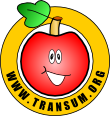
 |
Domain and RangeFind the domain and range of various functions expressed in different ways |
This is level 1; Describe the domain in plain English. You can earn a trophy if you get at least 7 questions correct.
InstructionsTry your best to answer the questions above. Choose one of the five possible answers. When you have finished click the "check" button. If you have any questions wrong, do your best to do corrections but if there is anything you don't understand, please ask your teacher for help. When you have got all of the questions correct you may want to print out this page and paste it into your exercise book. If you keep your work in an ePortfolio you could take a screen shot of your answers and paste that into your Maths file. You can also claim a 'Transum Trophy' by completing this quiz. |
||
|
|
||
Transum.orgThis web site contains hundreds of free mathematical activities for teachers and students. Click here to go to the main page which links to all of the resources available. Please contact us if you have any suggestions or Questions.
|
|
More Activities: |
|
Comment recorded on the 1 February 'Starter of the Day' page by Terry Shaw, Beaulieu Convent School: "Really good site. Lots of good ideas for starters. Use it most of the time in KS3." Comment recorded on the 19 October 'Starter of the Day' page by E Pollard, Huddersfield: "I used this with my bottom set in year 9. To engage them I used their name and favorite football team (or pop group) instead of the school name. For homework, I asked each student to find a definition for the key words they had been given (once they had fun trying to guess the answer) and they presented their findings to the rest of the class the following day. They felt really special because the key words came from their own personal information." |
Teacher! Are you delivering Maths lessons online? Tutors! Are your tutorials now taking place via a video link? Parents! Has home-schooling been thrust upon you at short notice? There are many resources to help you on the Maths At Home page. From ready made lesson plans to software suggestions and it's all free. Stay safe and wash yout hands! |
|
AnswersThere are answers to this exercise but they are only available to teachers who have subscribed to Transum and are currently signed in on this computer. A Transum subscription unlocks the answers to most of the student online exercises, quizzes and puzzles. It also provides the teacher with access to quality external links on each of the Transum topic pages so that teachers can easily find the excellent resources we have found and add to the collection themselves. Class lists, lesson plans and assessment data can also be stored in the Class Admin application and the teacher also has access to the Transum Trophies earned by class members. |
||
Go MathsLearning and understanding Mathematics, at every level, requires learner engagement. Mathematics is not a spectator sport. Sometimes traditional teaching fails to actively involve students. One way to address the problem is through the use of interactive activities and this web site provides many of those. Click here for more activities designed for students in upper Secondary/High school. |
||
TeachersIf you found this activity useful don't forget to record it in your scheme of work or learning management system. The short URL, ready to be copied and pasted, is as follows: Alternatively, if you use Google Classroom, all you have to do is click on the green icon below. Do you have any comments? It is always useful to receive feedback and helps make this free resource even more useful for those learning Mathematics anywhere in the world. Click here to enter your comments. |
||
© Transum Mathematics 1997-2025
Scan the QR code below to visit the online version of this activity.
https://www.Transum.org/go/?Num=1144
Close
❎Domain, Range and Asymptotes - A simple matching puzzle to get you started.
Level 1 - Describe the domain in plain English
Level 2 - Describe the domain in set notation
Level 3 - Describe the domain using interval notation
Level 4 - Describe the domain and range using a mix of notations
Exam Style Questions - A collection of problems in the style of GCSE or IB/A-level exam paper questions (worked solutions are available for Transum subscribers).
More on this topic including lesson Starters, visual aids, investigations and self-marking exercises.
This is the most straightforward way to describe a domain using everyday language.
This notation uses set-builder notation with curly brackets to describe the domain mathematically.
Key symbols:
This notation uses intervals to describe ranges of numbers on the number line.
Key symbols:
| Function Type | Restriction | Reason |
|---|---|---|
| \(\frac{1}{x-a}\) | \(x \neq a\) | Cannot divide by zero |
| \(\sqrt{x-a}\) | \(x \geq a\) | Cannot take square root of negative numbers |
| \(\frac{1}{\sqrt{x-a}}\) | \(x > a\) | Cannot divide by zero AND cannot have negative under square root |
| \(\log(x-a)\) | \(x > a\) | Logarithm only defined for positive numbers |
This video is from The Organic Chemistry Tutor.
Don't wait until you have finished the exercise before you click on the 'Check' button. Click it often as you work through the questions to see if you are answering them correctly. You can double-click the 'Check' button to make it float at the bottom of your screen.
Answers to this exercise are available lower down this page when you are logged in to your Transum account. If you don’t yet have a Transum subscription one can be very quickly set up if you are a teacher, tutor or parent.
Close
❎